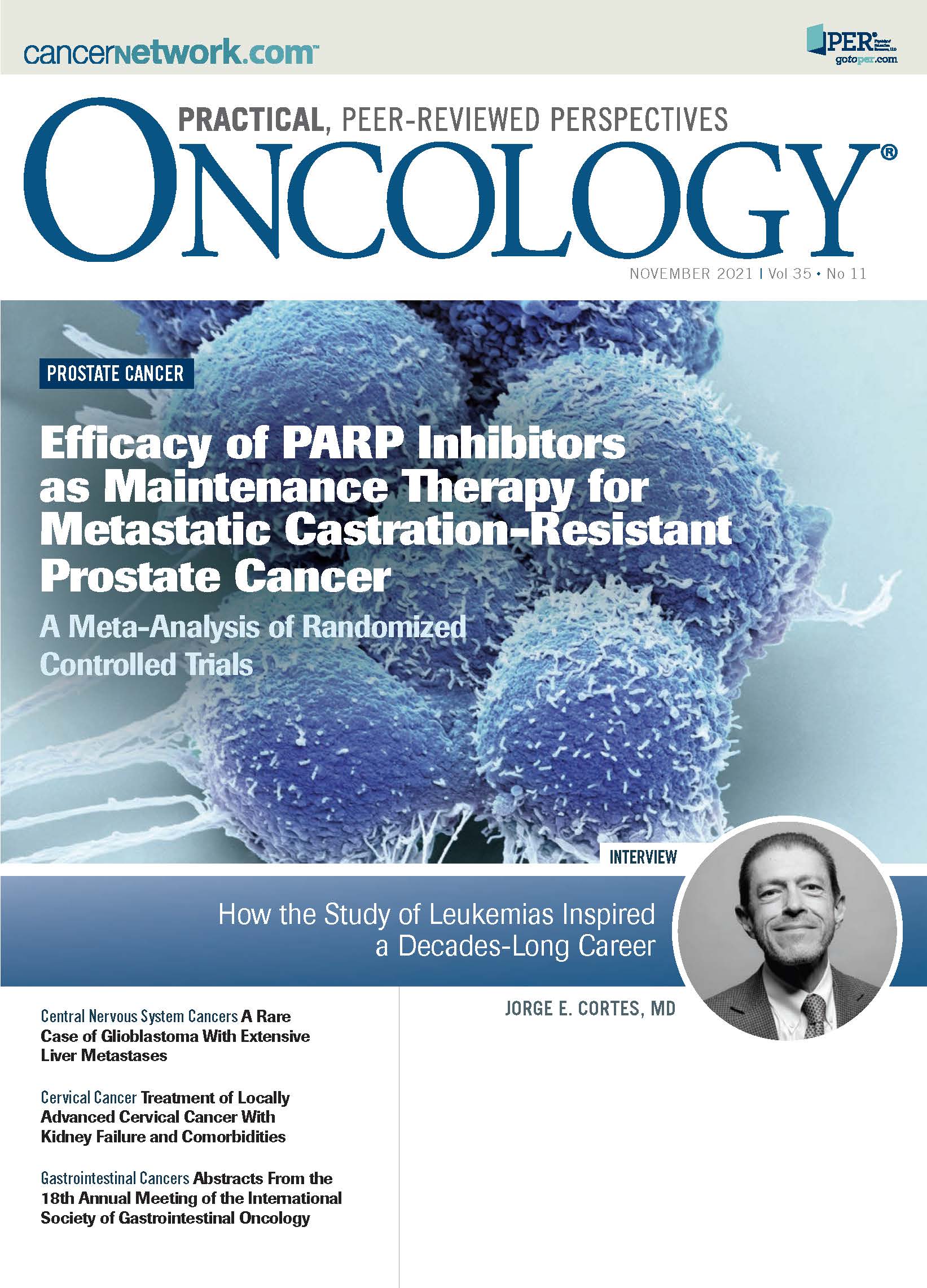Abstracts From the 18th Annual Meeting of the International Society of Gastrointestinal Oncology
The International Society of Gastrointestinal Oncology (ISGIO), hosted by Physicians’ Education Resource, LLC (PER®) presented the latest advances in the field of gastrointestinal cancer research.
TANIOS S. BEKAII-SAAB, MD, FACP
Professor, Mayo Clinic College of Medicine and Science
Program Leader, Gastrointestinal Cancer
Mayo Clinic Cancer Center
Consultant, Mayo Clinic
Consortium Chair, Academic and Community Cancer Research United (ACCRU)

HOWARD S. HOCHSTER, MD
Distinguished Professor of Medicine
Rutgers Robert Wood Johnson Medical School
Associate Director for Clinical Research
Rutgers Cancer Institute
Director of Oncology Research, RWJBarnabus Health
New Brunswick, NJ

The 18th Annual Meeting of the International Society of Gastrointestinal Oncology (ISGIO), hosted by Physicians’ Education Resource, LLC (PER®), was held as a 2-day virtual event on October 1-2, 2021. This multidisciplinary educational conference is dedicated to presenting and discussing some of the latest advances in the field of gastrointestinal cancer research.
Herein, ONCOLOGY® presents abstracts from the meeting, which was led by the journal’s Gastrointestinal Cancer Tumor Chair Tanios S. Bekaii-Saab, MD, FACP, along with one of its co-Editors-in-Chief Howard S. Hochster, MD.
Head-to-head comparison of a risk-adapted screening strategy incorporating different risk-prediction models in detecting advanced colorectal neoplasm
Ming Lu, MBBS1; Yuhan Zhang, MBBS1; Jie Cai, MPH2; Bin Lu, MBBS1; Chenyu Luo, MBBS1; Hongda Chen, PhD1,*; and Min Dai, PhD1,*
1Office of Cancer Screening, National Cancer Center/National Clinical Research Center for Cancer/Cancer Hospital, Chinese Academy of Medical Sciences and Peking Union Medical College, Beijing 100021, China; 2Department of General Surgery, Peking Union Medical College Hospital, Chinese Academy of Medical Sciences and Peking Union Medical College, Beijing 100730, China.
*Co-corresponding author
Learning Objective
To search for potential eligible risk-prediction models using a systematic literature review, and to validate model performance when it was incorporated into a risk-adapted screening strategy in a subset of a large-scale colorectal cancer (CRC) screening cohort in China.
Background
The risk-adapted screening strategy incorporating the Asia-Pacific Colorectal Screening score and fecal immunochemical test (FIT) showed satisfying CRC screening yield and efficiency. Previous research groups have developed a series of risk-prediction models for advanced colorectal neoplasms. Whether performance of different risk-prediction models would affect the yield of risk-adapted screening has not been evaluated. We further explored the diagnostic performance variation of this strategy using different risk-prediction models.
Methods
A literature search was conducted to identify studies evaluating risk models for advanced colorectal neoplasm (ACN). The included models were retrospectively validated in a subset sample (N = 3219) from a population-based CRC screening trial in China. The subset sample consisted of 265 patients with ACN (CRC, 24 patients; advanced adenoma, 241 patients) and 2,954 participants with no diagnosis of ACN. Diagnosis-related indicators were compared using different models and the FIT-only strategy. For simulated populations with ACN prevalence of 3% to 12%, the trade-off of additional false-positives for each additional true-positive was calculated.
Results
We included 14 eligible risk models (range of areas-under-the-curve, 0.570-0.652) in the validation set. The overall sensitivities of the risk-adapted screening strategy using different risk models for ACN varied from 46.0% to 69.8%; this was higher than seen with results of the FIT (21.9%), but at the expense of specificity (risk-adapted screening strategy, 51.6%-78.3%; FIT, 97.1%). For populations having an ACN prevalence of 3%, risk-adapted screening strategies needed 20.5 to 31.1 additional false-positives for each additional true-positive when compared with FIT results, and a respective number was substantially reduced (from 4.7 to 7.1) as the ACN prevalence increased to 12%.
Conclusions
A risk-adapted screening strategy using current risk models showed improved sensitivity for ACN as compared with results of FIT at the cost of increased colonoscopy workload. The optimal strategy for screening for CRC should be tailored according to disease burden and availability of health care resources.
Patient and provider factors associated with colorectal cancer screening in a large US claims database
Nicole M. Engel-Nitz, PhD1; Lesley-Ann Miller-Wilson, MS, PhD, MBA2; Lisa Le, MS1; Paul Limburg, MD, MPH, AGAF3; Deborah Fisher, MD, MHS4
1Optum, Eden Prairie, MN, USA; 2Exact Sciences, Madison, WI, USA; 3Mayo Clinic, Rochester, MN, USA; 4Eli Lilly and Company, Indianapolis, IN, USA
Learning Objective
To understand patient and provider factors that could be targeted systematically to improve engagement in average-risk colorectal cancer (CRC) screening.
Background
Despite the demonstrated effectiveness of average-risk CRC screening, approximately one-third of screening-eligible US adults are not up to date with this important preventive service.
Methods
The study included individuals (age, 50-75 years) in a large, deidentified claims database that had continuous enrollment during the year of analysis and 1 year prior. The average-risk population excluded those with high-risk conditions (eg, CRC familial syndromes, adenoma, sessile serrated polyp, history of or current diagnosis of CRC, family history of gastrointestinal cancer, inflammatory bowel disease). Patients were selected if they received screening (ie, colonoscopy, fecal immunochemical test, fecal occult blood test, multitarget stool DNA test, flexible sigmoidoscopy/CT colonography) during their last complete year of analysis. Control patients were randomly selected ; they did not have high-risk conditions for CRC and did not claim to have a screening test during the analysis year or any previous year. Cases and controls were compared on baseline demographic and clinical characteristics and screening opportunities as measured by number of baseline health care visits. Logistic regressions modeled the impact of characteristics on screening.
Results
A total of 664,234 screened and 548,758 unscreened patients were included in the analysis. Screened patients had higher odds of being female (odds ratio [OR], 1.22; 95% CI, 1.21-1.23), commercially insured, and a resident of both the southern United States and an urban setting. Screened patients also had higher odds of having completed 12th grade or having a bachelor/graduate degree; the odds of being screened increased as net worth increased. Patients who had a primary-care visit (OR, 2.69; 95% CI, 2.67-2.71), a preventive-care visit, or a main primary-care provider had the greatest odds of being screened.
Conclusions
The greatest predictors for CRC screening were having a primary-care visit, having a main primary-care provider, and having a recent preventive-care visit. Potential targeted interventions for providers and patients include increasing access to and use of preventive-care visits and interventions not dependent on a clinical visit (eg, mailed CRC screening tests).
Disclosures: Funding for this study was provided by Exact Sciences to Optum. N Engel-Nitz, L Le are employees of Optum and shareholders in UnitedHealth Group. L Miller-Wilson is an employee of Exact Sciences. P Limburg serves as chief medical officer for screening at Exact Sciences through a contracted services agreement with Mayo Clinic. Limburg and Mayo Clinic have contractual rights to receive royalties through this agreement. D Fisher has been a consultant with Exact Sciences and Guardant Health; she is currently employed by
Lilly and Co.
The impact of combined DNA repair and oncogene mutations in colorectal cancer survival
Keeley Barnable, BSc,1 Vett Lloyd, BSc, Diplome, PhD,1 Gurpreet Singh Ranger, BSc, MSc, MS, MRCS, FCBS, FRCS, FRCSGlasg1,2
1Mount Allison University, Sackville, NB, Canada; 2Upper River Valley Hospital, NB, Canada
Learning Objective
To determine the impact of selected gene mutations on survival in patients with colorectal cancer (CRC) from a rural population in New Brunswick, Canada.
Background
Testing for multiple mutations in CRC allows insight into pathways of cancer development and disease outcomes and use for targeted treatment. This study examined the coexistent effect of either KRAS or BRAF gene status with mismatch repair (MMR) gene function on patient outcomes in New Brunswick, Canada.
Methods
In this retrospective study, mutation status for MMR and other oncogenes was derived from DNA sequencing and immunohistochemistry. Patients with the given genotypes were assessed for overall survival probability using Kaplan-Meier statistics. Significant differences were calculated using the log-rank test (alpha = .05).
Results
The study involved 117 patients (mean age, 69.6 ± 10.4 years; male:female ratio; 1.34:1). Analysis of survival outcomes showed significantly poorer survival in patients with mutations of KRAS or MLH1 alleles (P = .018) when compared with patients who did not harbor these genetic mutations. Borderline significant results for poorer survival were noted among patients with the PMS2 mutant phenotype, even with wild-type KRAS (P = .056). No other significant results were noted with KRAS or BRAF mutations paired with MMR mutations or wild-type alleles.
Conclusions
These results supported previous findings that discovery of mutant oncogenes and altered MMR genes are predictive of survival. As expected, the presence of the mutant MLH1 phenotype confers significantly reduced patient survival. Due to the relatively small sample size, these
preliminary results should be interpreted cautiously. Based on borderline insignificant pairwise analysis, further analyses using larger sample sizes may reveal more significant associations between known oncogenes and MMR genes and their combined effect on survival.
Gastric cancer with aberrant CLDN6 expression procures reduced cytotoxic activity
Sanyog Dwivedi,1,2 Erika P. Rendón-Huerta,1 Vianney Ortiz-Navarrete,2 and Luis F. Montaño1
1Immunobiology Laboratory, Department of Cell and Tissue Biology, Faculty of Medicine, UNAM, Mexico; 2Department of Molecular Biomedicine, Center for Research and Advanced Studies, IPN, Mexico.
Learning Objective
To understand the association between CLDN6 and immune suppression in gastric cancers.
Background
CLDN6, a tight junction protein aberrantly expressed in patients diagnosed with gastric cancer (GC), supports epithelial-to-mesenchymal transition, cancer progression, and survival. Immune suppression and exhaustion of cytotoxic natural killer (NK) and T cells is another prominent characteristic of advanced GC. Considering the above, we are interested in seeing if CLDN6 is also associated with the reduced cytotoxic activity of immune cells in GC.
Methods
CBioPortal was used to access The Cancer Genome Atlas Stomach Adenocarcinoma (TCGA-STAD) Pan-Cancer Analysis Project data of 440 GC samples. These samples were divided into 2 groups according to mRNA expression: z-scores (relative to normal samples, log RNASeq V2 RSEM) of CLDN6 were considered to be high if greater than 5 (71 samples; CLDN6-high) and low if less than 1 (254 samples; CLDN6-neg). The mRNA z-scores were analyzed using MS Excel and GraphPad Prism 8.
Results
Cytotoxic activity of NK cells depends on synergistic engagement and activation of several activation receptors that downregulate in several cancers, including GC. The mRNA expression of several important receptors and ligands related to the activation of cytotoxic cells were analyzed between groups having CLDN6-high and CLDN6-neg GC samples. NKG2D, one of the key receptors for NK cell activation, was downregulated in GC samples having high CLDN6 expression relative to CLDN6-neg group samples. The NKG2D ligand ULPB1 was significantly upregulated in CLDN6 group samples, although no change in the mRNA levels of MICA, MICB, or other ULBPs were noticed among the groups. The natural cytotoxicity receptors NKp44 and NKp46 were also significantly downregulated in the CLDN6-high group samples. Other important receptors necessary for NK cell activation and IFNϒ secretion (eg, CD244, DNAM1, CD28, CD69, and CD38) were also downregulated in CLDN6-high group samples. Additionally, high CLDN6 expression was related to the downregulation of important cytokines like IL15 and IFNϒ, which affected the activation and activity of several immune cells. Cytolytic activity of cytotoxic cells largely depends on cytolytic granule contents (eg, perforin, granzyme, and ligands of death receptors, including FasL and TRAIL). Samples in the CLDN6-high group demonstrated a significant downregulation in FasL, TRAIL, and perforin mRNA levels, indicating reduced cytolytic activity in these samples.
Conclusions
Collectively, these results indicated that aberrant expression of CLDN6 in GC is associated with the downregulation of cytolytic activity of cytotoxic cells.
Acknowledgments: This research was supported by CONACYT
CVU grant 871712 and PAPIIT grants IN221519 and IN218019.
Peritoneal carcinomatosis leveraging ctDNA-guided treatment in GI cancer study (PERICLES study)
Sharon Li, MD; Timothy Kennedy, MD, MBA; Patrick Boland, MD; Kristen Spencer, MD, MPH; Lyudmila Berim, MD; Prateek Gulhati, MD, PhD; H. Richard Alexander, MD*; Howard S. Hochster, MD*.
*Co-Principal Investigators.
All affiliated with Rutgers Cancer Institute of New Jersey
Learning Objective
To follow circulating tumor DNA (ctDNA) as a marker of response to various interventions for peritoneal carcinomatosis (PC) to determine whether it may be used to guide treatment decisions.
Background
Peritoneal carcinomatosis (PC) is a frequent complication of numerous gastrointestinal (GI) cancers, but cross-sectional imaging is notoriously unreliable in detecting extent of disease. Analysis of circulating tumor DNA (ctDNA) is emerging as a noninvasive method to detect cancer-specific molecular alterations in the blood of patients with various tumor types, with applications in cancer surveillance and management. In patients with PC, serial assessments of
ctDNA may be a better option than conventional imaging to assess for disease progression.
Methods
This pilot study will enroll a total of 30 adult patients with PC from any GI malignancy that are candidates for cytoreductive surgery (CRS) at the Rutgers Cancer Institute of New Jersey. This study will be conducted with Natera, Inc, using Signatera, a platform that creates a personalized minimal residual disease (MRD) assay for tracking ctDNA in each patient. Plasma for ctDNA at baseline, presurgery, postsurgery, and every 3 months for 2 years will be obtained in follow-up. Change in ctDNA levels with (1) chemotherapy, (2) CRS, and (3) clinical disease progression will be evaluated and compared with conventional definitions of disease progression (eg, rise in conventional tumor markers, radiographic progression). Participants’ ctDNA findings will be followed and used for decisions pertaining to further chemotherapy after surgical debulking.
The primary end point is to determine plasma ctDNA clearance rates with chemotherapy and CRS with or without hyperthermic intraperitoneal chemotherapy, with ctDNA clearance rate defined as the percentage of patients on the protocol with undetectable ctDNA. Any ctDNA changes will be associated with clinical response by RECIST and surgical staging, surgical outcomes, peritoneal cancer index, and completeness of cytoreduction score using standard T-testing, log-rank analysis, or similar nonparametric testing. Multivariate analysis will be used, as appropriate. All results will be reported using descriptive statistics and a 95% confidence interval.
Status
The trial is currently screening eligible subjects, with an anticipated completion date around 2024. ClinicalTrials.gov identifier: NCT04929015.
